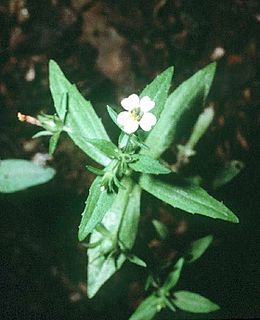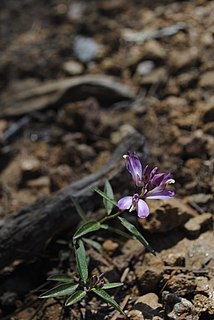
Gilia scopulorum is a species of flowering plant in the phlox family known by the common names rock gilia and Rocky Mountain gilia. It is native to the Mojave and Sonoran Deserts.

Alyssum alyssoides is a species of flowering plant in the mustard family known by several common names, including pale madwort and yellow alyssum. It is native to Eurasia, but it can be found throughout much of the temperate world as an introduced species and sometimes a common weed.
Bloomeria humilis is a rare species of flowering plant that is known by the common name dwarf goldenstar. It is endemic to San Luis Obispo County, California, where it is known from only one occurrence on the coastline near San Simeon.

Calochortus greenei is a species of flowering plant in the lily family known by the common name Greene's mariposa lily. It is native to northern California and southern Oregon, where it grows in the forest and woodlands of the mountains. It is a perennial herb which produces a branching stem up to about 30 centimeters in maximum height. There is a basal leaf about 20 centimeters long which does not wither at flowering. The inflorescence bears 1 to 5 erect bell-shaped flowers. Each flower has three sepals and three light purple petals with darker areas at the bases. The petals are 3 to 4 centimeters long and have a coat of long hairs on their inner surfaces. The fruit is a winged capsule about 2 centimeters long.

Calochortus obispoensis is a rare California species of flowering plants in the lily family known by the common name San Luis mariposa lily. It is endemic to San Luis Obispo County, California, where it grows in the chaparral of the coastal mountains, generally on serpentine soils.

Camissonia contorta is a species of evening primrose known by the common name plains evening primrose. It is native to western North America from British Columbia to California to Idaho, where it grows in many habitat types. It is an annual herb producing a slender, bending to curling red or green stem which is sometimes hairy. It is up to 30 centimeters long and erect or spreading out. The blue-green leaves are linear to very narrowly oval in shape and up to 3.5 centimeters long. The nodding inflorescence produces one or more small flowers. Each has bright yellow petals up to half a centimeter long, sometimes with small red dots near the bases. The fruit is a capsule about 3 centimeters long containing shiny seeds.

Camissoniopsis hardhamiae is a species of evening primrose known by the common name Hardham's evening primrose. It is endemic to California, where it grows in the chaparral and woodland of San Luis Obispo and Monterey Counties. It is a robust annual herb producing a hairy stem up to about half a meter tall. The leaves are lance-shaped to narrowly oval and up to 12 centimeters long. The nodding inflorescence bears flowers with yellow petals each a few millimeters long. The fruit is a cylindrical capsule up to 2.5 centimeters long containing several dark-colored seeds.

Camissoniopsis hirtella is a species of evening primrose known by the common name Santa Cruz Island suncup. It is native to California and Baja California, where it grows on the slopes of coastal and inland hills and mountains, especially in areas that have recently burned. It is an annual herb producing a hairy stem up to about half a meter in height. Most of the leaves are located in a basal rosette at ground level and are oval in shape and a few centimeters in length. The nodding inflorescence produces flowers with sepals coated in long, glandular hairs, and bright yellow petals under a centimeter long each. The petals sometimes have red dots at their bases. The fruit is a coiling capsule up to 2 centimeters long.
Tetrapteron palmeri is a species of evening primrose known by the common name Palmer evening primrose. It is native to the western United States from California to Idaho, where it grows in several habitat types, including desert and sagebrush. It is a roughly hairy annual herb growing in a low patch on the ground, generally with no stem. The leaves are widely lance-shaped and up to about 5 centimeters long, with a few small teeth along the edges. The nodding inflorescence produces flowers with yellow petals only 2 or 3 millimeters long each and a noticeable bulbous stigma tip which may be up to a centimeter wide. The fruit is a leathery capsule around half a centimeter long with small wings near the tip.
Chylismiella pterosperma is a species of evening primrose known by the common name wingfruit suncup and is the only species in the monotypic genus Chylismiella. It is native to the western United States, where it grows in several habitat types, including sagebrush. It is a slender annual herb producing an erect stem up to about 14 centimeters in height. The leaves are up to 3 centimeters long and densely coated in bristly hairs. The nodding inflorescence produces flowers with white petals each less than 3 millimeters long. They are sometimes yellow near the bases and fade to a purple color as they wither. The fruit is a straight capsule about 1 to 3 centimeters long with a thick wing down the middle.
Camissonia pusilla is a species of evening primrose known by the common name little wiry suncup. It is native to the western United States from California to Idaho, where it grows in sagebrush and other habitat. It is a petite, hairy, glandular annual herb producing very slender erect stems up to about 22 centimeters in maximum height. The leaves linear with toothed edges and 1 to 3 centimeters long. The nodding inflorescence produces flowers with yellow petals 2 or 3 millimeters long and usually spotted with red near the bases. The fruit is a straight or coiling capsule up to 3 centimeters long.

Eremothera refracta is a species of evening primrose known by the common name narrowleaf suncup. It is native to the southwestern United States, especially desert areas. It is an annual herb producing a hairy red or reddish green leafy stem up to about 45 centimeters in maximum height. The nodding inflorescence produces flowers with white petals a few millimeters long which turn reddish as they wither. The fruit is a straight or coiling capsule up to 5 centimeters long.
Campanula californica is a species of flowering plant in the bellflower family Campanulaceae, known by the common names swamp bellflower and swamp harebell. It is endemic to California, where it grows along the coastline between Marin and Mendocino Counties. It is found mainly in wet areas such as bogs, marshes, and wet forest floors. This is a hairy rhizomatous perennial herb producing a thin, creeping stem 10 to 30 centimeters long. The thin, rippled leaves are oval in shape and between 1 and 2 centimeters long. The bell-shaped flower is pale blue with curving petals up to 1.5 centimeters long. The fruit is a ribbed, spherical capsule.
Epilobium foliosum is a species of flowering plant in the evening primrose family known by the common names leafy willowherb and California willowherb. It is native to parts of western North America from British Columbia through California to Arizona, where it grows in many types of habitat, including disturbed areas.
Epilobium pallidum is a species of flowering plant in the evening primrose family known by the common name largeflower spike-primrose. It is native to western United States, where it grows in moist areas in northern California, Oregon, and Idaho. It is an annual herb producing a narrow, upright stem up to 60 centimeters long lined with narrow oval leaves each up to 5 centimeters in length. The inflorescence atop the stem bears several flowers and hairy, leaflike bracts. Each flower has four bilobed petals each up to about a centimeter long and bright pink in color. The fruit is a beaked capsule between 1 and 2 centimeters long containing a row of tiny seeds.

Gratiola neglecta is a species of flowering plant known by the common name clammy hedgehyssop. It is native to much of North America, including most all of the United States and the southern half of Canada. It is generally found in moist to wet habitat. This is an unobtrusive annual herb producing a glandular stem up to about 30 centimeters tall. The lance-shaped to oval leaves are arranged oppositely about the stem. They are up to 5 centimeters long and sometimes toothed along the edges. The inflorescence is a raceme of nearly cylindrical tubular whitish flowers each about a centimeter long. At the base of each flower is a fringe of five pointed sepals. The fruit is a spherical capsule about half a centimeter wide.
Narthecium californicum is a species of flowering plant known by the common name California bog asphodel. It is native to the mountains of southern Oregon and northern California, where it grows in wet habitat such as streambanks and meadows. It is a rhizomatous perennial monocot producing an erect stem up to about 60 centimeters tall. The base of the plant is surrounded by linear, grasslike leaves up to 30 centimeters long. The inflorescence is a raceme of many yellow flowers with six pointed tepals no more than a centimeter long. The fruit is a lance-shaped capsule containing many bristle-tailed seeds.

Oenothera wolfii is a rare species of flowering plant in the evening primrose family known by the common name Wolf's evening primrose. It is native to the coastline of southern Oregon and northern California, where it grows in coastal prairie, dunes, and coastal forest and woodland habitat. As of 1997 it was known from only about 16 occurrences. The biggest threat to the plant is its easy hybridization with its relative and probable descendant, Oenothera glazioviana. As this rare wild plant crosses with the introduced garden escapee, introgression occurs, causing what is known as genetic pollution; fewer pure individuals of O. wolfii will be seen as they are outnumbered by hybrids.
Phacelia adenophora is a species of phacelia known by the common name glandular yellow phacelia. It is native to the northwestern United States where it can be found in Oregon, northeastern California, and northwestern Nevada. It grows in mountain and plateau habitat. This is an annual herb producing decumbent, creeping, spreading, or upright branched stems up to 40 centimeters long. The leaves are oblong in shape and deeply lobed, measuring up to 3 centimeters long. The inflorescence is a one-sided cyme of many bell-shaped flowers each under a centimeter long. Unlike many phacelias, which bloom in shades of blue and purple, this species has yellow to golden flowers. It occasionally has purple edges on the corolla. The fruit is a fuzzy, oblong capsule a few millimeters in length containing up to 14 seeds.

Rhinotropis californica, synonym Polygala californica, is a species of flowering plant in the milkwort family known by the common name California milkwort. It is native to southwestern Oregon and northern and central California, where it grows in the coastal mountain ranges in local habitat types such as chaparral and forest. It is a perennial herb producing spreading stems, generally decumbent in form, up to about 35 centimeters in maximum length, lined with narrow oval leaves each a few centimeter long. The upper inflorescences produce several open flowers, and there may be some closed, cleistogamous flowers lower on the plant. The open flowers have pink or white winglike lateral sepals with hairy edges. The petals are similar in color, the central one tipped with a white or yellow beak. The fruit is a flattened green capsule up to a centimeter long containing hairy seeds.











